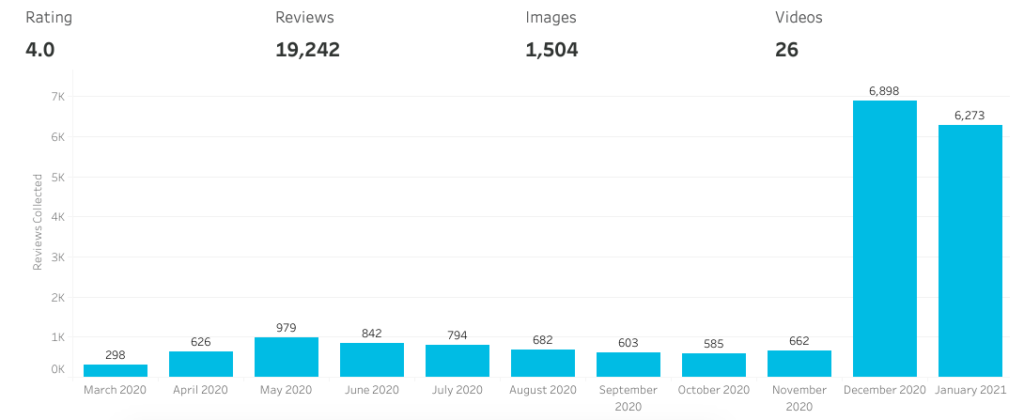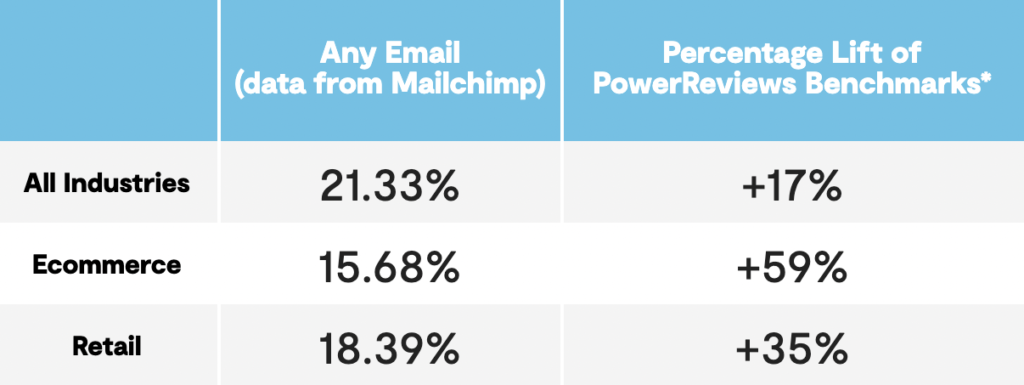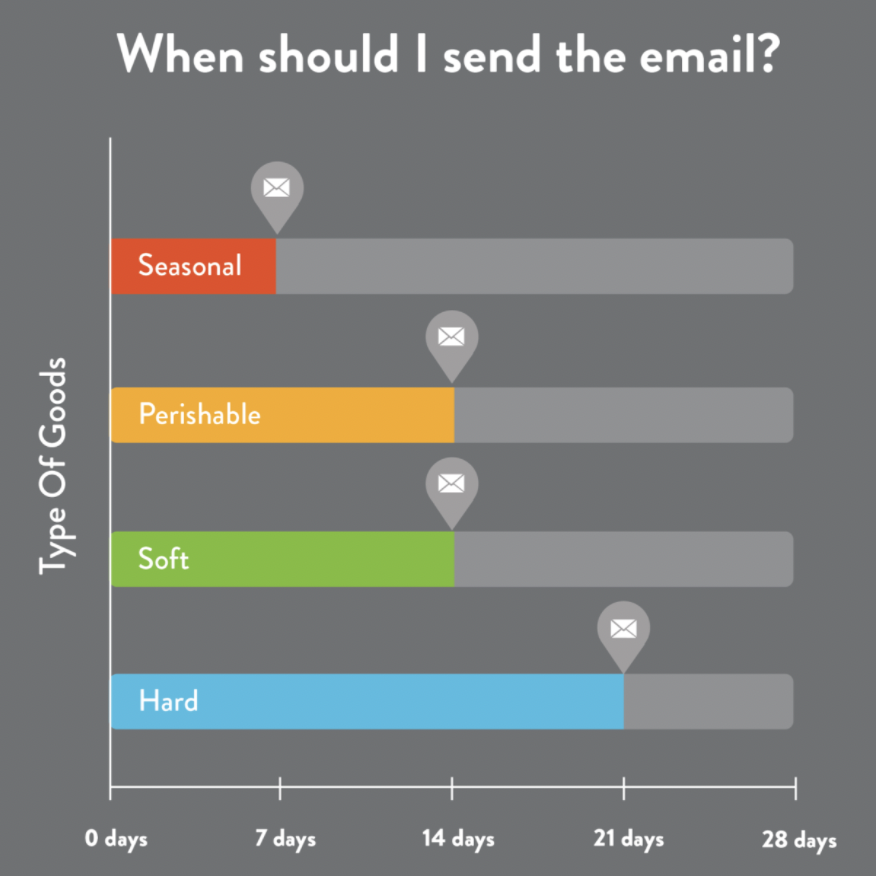- Emails are a key medium for review collection. Between 60% to 90% of all reviews originate from an email request.
- PowerReviews review request emails have an average open rate 59% higher than ecommerce benchmarks.
- Retailers can optimize email open rates with stronger subject lines. Pro tips include personalizing subject lines, offering an incentive, and A/B testing.
There’s a direct relationship between review collection and sales. When retailers add reviews to their product pages, they see an instant bump in traffic and sales. In fact, consumers who interact with ratings and reviews convert at 108.4% the rate of those who don’t. This probably isn’t surprising given reviews are such an important part of the purchase consideration process – with 99.9% of consumers now claiming they read them.
There are a number of ways retailers can boost their review collection efforts, but none are more powerful, impactful and widely-used as email.
Emails are a key medium for review collection. According to our data, between 60% to 90% of all reviews originate from an email request. After implementing review request emails, one of our customers in the home improvement space saw over a 1,000% increase in review volumes the very next month!

If the data tells us anything, it’s that if you send a post-purchase email, a review is good as collected. There’s only one thing standing in your way. Customers have to actually open your email.
A Quick Review of Email Open Rates
According to Mailchimp’s latest benchmarks for 2021, the average email open rate is 21.33% across industries. For ecommerce, it’s 15.68%, and for retail, it’s 18.39%.
There’s good news here. At PowerReviews, our open rates for post-purchase review collection emails are all either in-line, or above, Mailchimp’s benchmarks — suggesting that consumers are even more interested in opening emails that request they share their feedback with a retailer.
Our overall unique open rate is approximately 25% (which is 17% higher than the average from Mailchimp’s data). Our open rates are 59% higher than Mailchimp’s for ecommerce, and 35% higher for retail. (These figures are based on nearly 175 million emails sent from 600+ merchants, as of June 22, 2021.)

(data from Mailchimp)
The data tells us consumers want to write reviews. Earlier this year, we surveyed more than 10,000 active shoppers in the U.S. and nine out of ten reported that they write a review at least once every six months. The better news? 91% of those who do, are motivated by a desire to share a particularly positive experience. All retailers need to do is get them to open their email so they have a chance to.
If you want to increase your email open rates, it all comes down to your subject line. It follows, then, that if you want more reviews, you need to optimize your email subject lines. Here are eight dos and don’ts to help you do just that.
5 Email Subject Line Dos
Follow these five email subject line tips to boost your review collection efforts.
1. DO personalize your subject lines when possible
Personalization is the holy grail of retail marketing. Why? Because consumers are much more likely to respond to something that is highly relevant to them. Customers are 29% more likely to open an email personalized to them, according to Mailchimp.
Plus, adding the recipient’s name to your subject line helps your email bypass spam filters (since you’re using their name). Next time, try an email subject line like “We want details! How would you rate your recent purchase, [Name]?”
2. DO be descriptive, but keep it short
Shorter is always better in today’s world of short attention spans. No one wants to read a paragraph. Write shorter email subject lines, and you don’t have to worry about your subject line getting cut off. Aim for around 40 characters, or 7 words.
This best practice is especially important if the majority of your customers read email on a mobile device (as most people do nowadays).
3. DO include a promotion or contest
Predictably, incentive-based emails get the best open rates (who doesn’t want a chance to win free swag?). However, we’d recommend exercising caution when running a review promotion because ISPs sometimes identify these emails as spam. To avoid your email getting marked as spam, try:
- Testing your email with a smaller set of customers before launching the campaign to everyone.
- Including the contest language in the email header so it shows up in the preview instead of the subject line.
Don’t worry too much about sounding spammy. If you’ve emailed these shoppers before (which you probably have when you sent their order confirmation emails), their ISP may already recognize you as a trusted sender and send you straight to their inbox anyway.
Here are some of the top-performing email subject lines we’ve seen:
- Your review is worth $1000!
- Review and Earn at [your brand]
- Review and Win!
- Rate your purchase for a chance to win!
- Tell us what you think!
- If you loved it, let us know!
- Review Your Purchase and Receive $10 off Your Next Purchase
According to our data, emails with subject lines mentioning a contest or gift also consistently top the list for review completion rate (meaning that customers actually click through and submit a review after opening the email). One of our apparel clients implemented a review sweepstakes for 45 days and saw a 290% increase in collection rates during that time! They now run it sporadically throughout the year and have more than doubled the amount of user-generated content they collect in a year.
4. DO send at the right times
You can craft the most fantastic, intriguing, ultra-optimized email subject line — but your effort will be completely wasted if your customers never see it. Make sure to send your emails at the prime time to optimize both open rates and review completion rates.
When should you send your review request email?
You want to give your customers sufficient time to use the product so they feel comfortable leaving a review, without waiting so long that you’re no longer top of mind. We recommend sending your review request email between 1 to 3 weeks after the customer purchased the product. Here are the benchmarks we found work best for different types of products:
- Seasonal items: 7 days
- Soft goods: 14 Days
- Perishables: 14 Days
- Hard goods: 21 Days

If customers don’t open your first email, send them a follow up email 6 to 8 days later.
The best time of day to send emails is around 10am, 1pm, and 6pm, according to Hubspot. Those are averages across industries, and across email content. To find the best time to send review request emails for your brand, you can perform A/B testing, which brings us to our last tip.
5. DO consider A/B testing
Remember that your customers are unique. The “average” best practice may not apply to them. In addition to testing different send times, test a couple variations of your email subject lines. Track which subject line drives the best results, and iterate from there.
3 Email Subject Line Don’ts
Avoid these three email subject line mistakes when sending your post-purchase emails.
1. DON'T send from “do-not-reply” email accounts
No-reply email can be a death knell for your email delivery rates. Many ISPs filter emails sent from no-reply addresses as spam. Plus, it provides a frustrating experience for users — and for you. If there’s a problem with your review collection emails, but customers can’t reply, you’ll never know.
Instead, set up a dedicated email address for your review collection efforts, and ensure it’s monitored in case your customers reply.
2. DON'T include other marketing or sales calls-to-action
You know how they say, “Keep it simple, stupid”? The same goes for your emails. Don’t confuse your customers. Keep the call-to-action focused on review collection, and review collection alone — in both your subject lines and the email copy itself.
3. DON'T go crazy with hashtags and punctuation
Too much punctuation can make your subject line look spammy, especially if you use a lot of special characters (e.g. !!! or $). Hashtags (#) can also be flagged by spam. Stick to normal punctuation, and your email will appeal to customers and ISPs alike.
Get inspired with these top-performing email subject lines
Suffering from email writer’s block? When in doubt, rely on what works. These four examples have driven open rates above 40% (that’s a 61% increase over our average open rate) and review completion rates as high as 10% for brands and retailers we work with.
- “Please review your [brandname.com] purchase”
- “We’d love to hear what you think”
- “Review your recent order!”
- “Tell us about your new [brand name]”
If we could leave you with one last tip, it’s this. Make the ‘write a review’ action stand out. Make it clear to customers what you’re asking for, and you shall receive!





